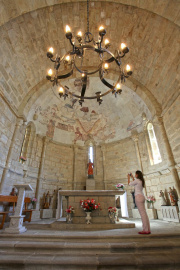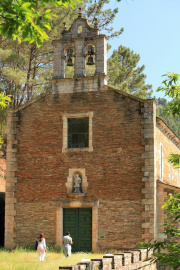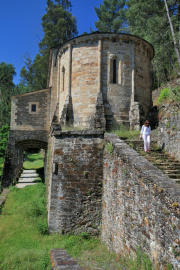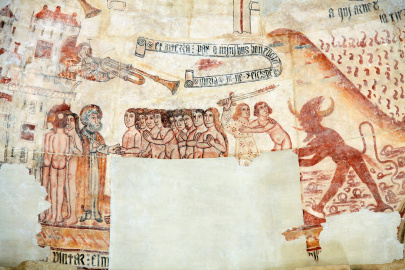

Church of Santo Estevo de Chouzán
In 1953 the former temple was moved to its current location, on the occasion of the building of the dam in Os Peares, but suffering considerable modifications.
The first documental news relate it to Oseira due to a donation of Alfonso VII, although its origin probably goes back to the 9th century, where “Aouzan” is under the titling of Santo Estevo as donation made by a "Flaminio" Knight and his wife "Remisilia".
As the majority of monasteries in the area, it disappeared with the reform supported by the Catholic Monarchs in 1499 to be annexed to San Paio de Antealtares. This way, it received the incomes and property of the old monastery in 1515 and it continued serving as the parish church of the Diocese of Lugo.
At the end of the 13th century or, according to some authors, beginning of the 14th century, it preserves the apse and the North Gate, as well as mural paintings in the interior dome of the apse which were also transferred at that time. Important parts of these paintings and also of the temple were lost. They are from the beginning of the 16th century and have hispano-flamenco Gothic influence.
The epigraph which is preserved in its northern gate shows it was founded on the 1st April 1314 by the Abbess Teresa Arias.
The current church shows perfectly in the use of different materials the rebuilt parts according to the original model exactly. In order to do so, the original parts were renumbered for being relocated. There are still some marks of that process. It is known that its initial plant was cross-shaped, which was an atypical feature in the area in relation to the Romanesque art.
The apse is built with a rectangular section covered with a barrel vault and oven-vaulted semicircular front. The front is divided into five sections with attached columns and capitals decorated with different motifs.
Inside there is a triumphal semicircular arch decorated with columns and capitals with vegetal decoration.
The paintings are placed chronologically in the first half of the 16th century. It represents a Final Judgement, where we can appreciate very funny and irreverent attitudes in hell. Apparently, they were from considerable quality but were lost in the transfer. The Final Judgement is presided over by a judge Christ, with his feet on the Earth, where Europe, Africa and Asia were highlighted. On both sides, there is the celestial court and martyrs.
Under heaven and hell, San Pedro architectures welcome the elect, while several demons are tormenting the damned. The message given to the faithful is as always clear and concise.
No doubt the Gothic connotations in Chouzán do not let us forget that we are in an area closely linked to the Matthew tradition, through the diaspora of teachers and workshops from the art of Matthew and the Cathedral of Compostela, or through the centre of Ourense. Their shapes are quite similar to the neighbouring church of Santo Estevo de Atán that we can see on the other side of the river Miño.
Saint Stephen is widely advocated in these lands. A martyr condemned by uttering blasphemous against Moses and against God, the Sanhedrin sentenced him to stoning. That is why he is often represented with a basket or pile of stones, and a book and deacon's dalmatic.
Through a path between vineyards and looking at unknown views of the river Miño we arrived at the church of Chouzán, which lies embedded in the slope of the hill.It must be highlighted the columns supporting the sacristy, which emerges about the path we must go through to admire its entire apse.
You can take a 360º virtual tour clicking here.
Santo Estevo de Chouzan
Information and contact

Chouzán
Carballedo
27532 Lugo
 Directions
Directions 






 What would you improve?
What would you improve?